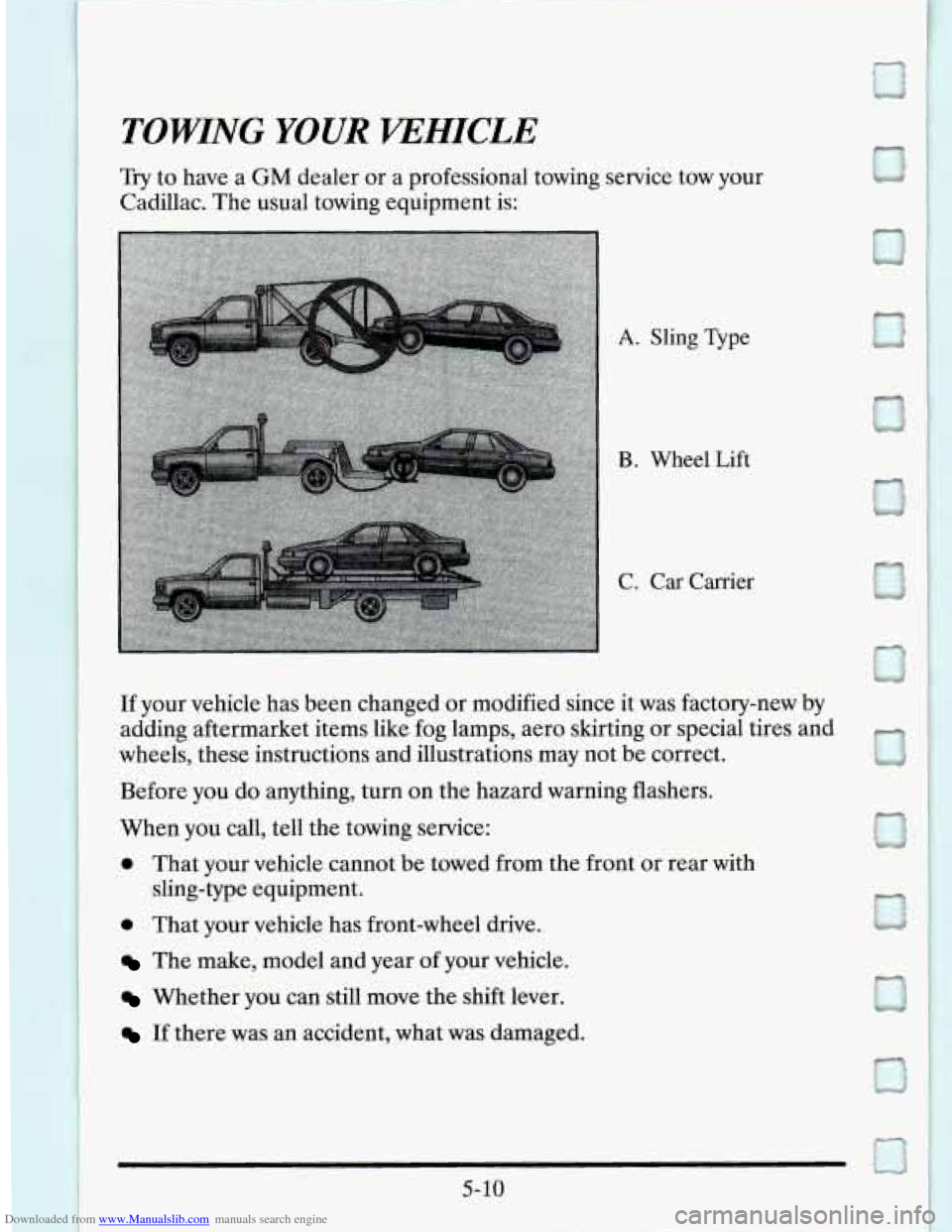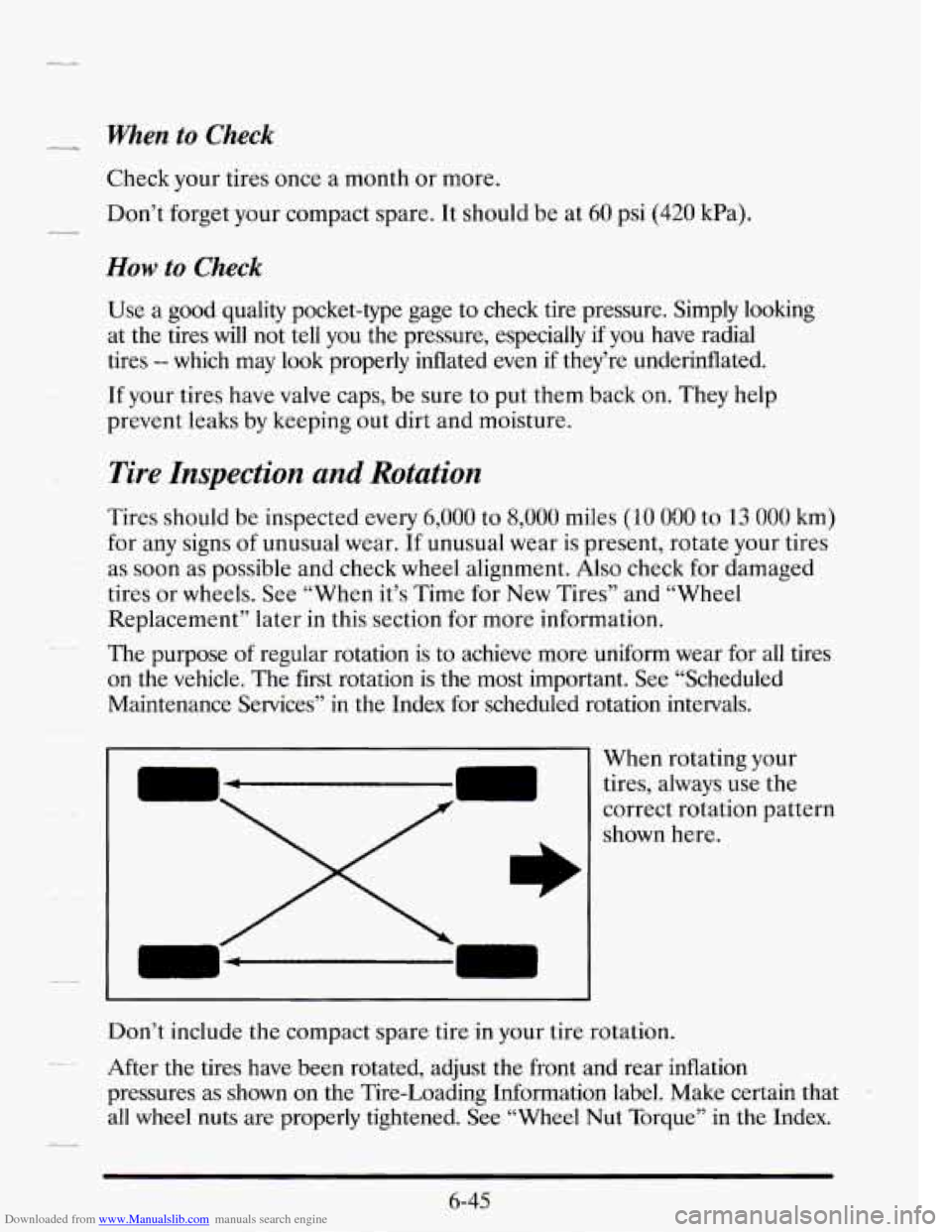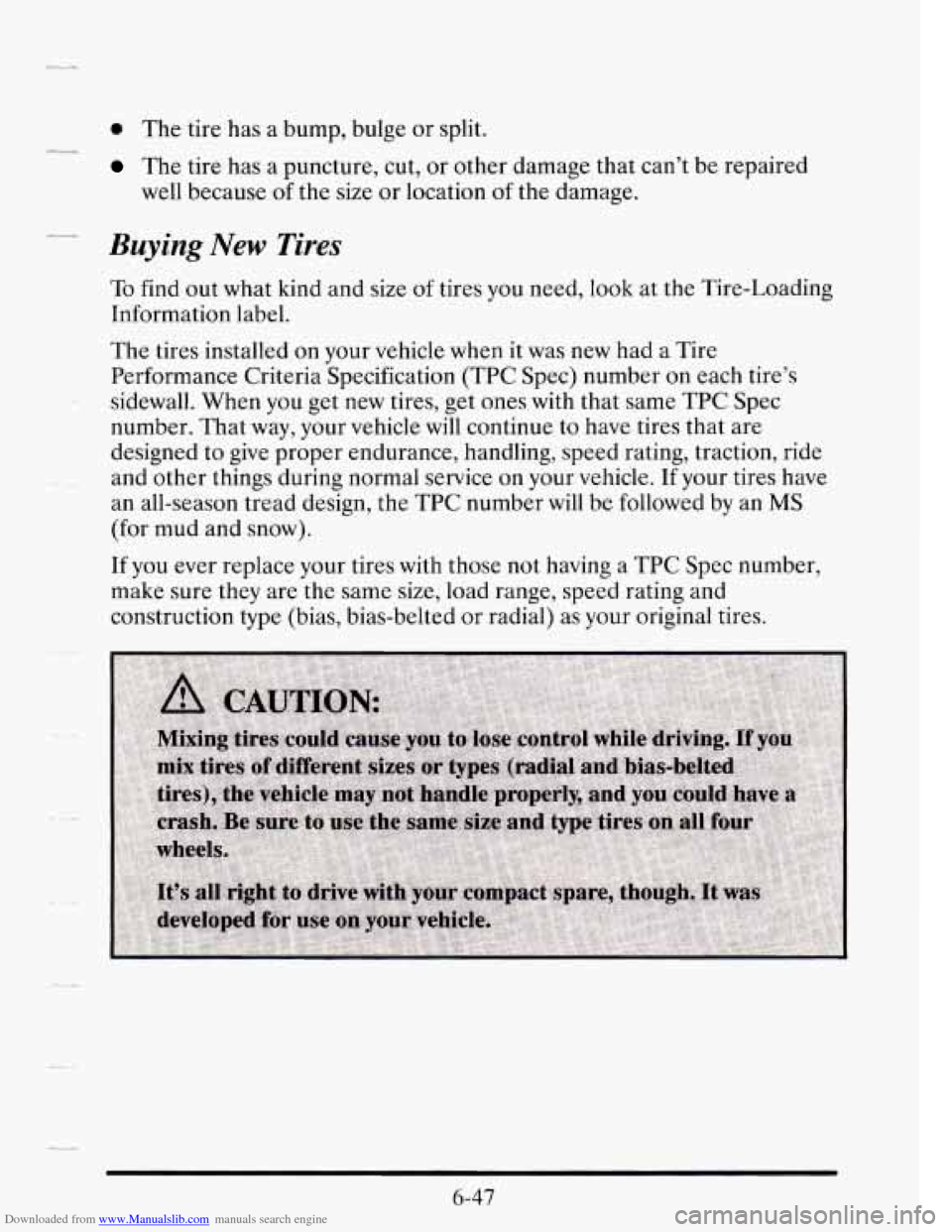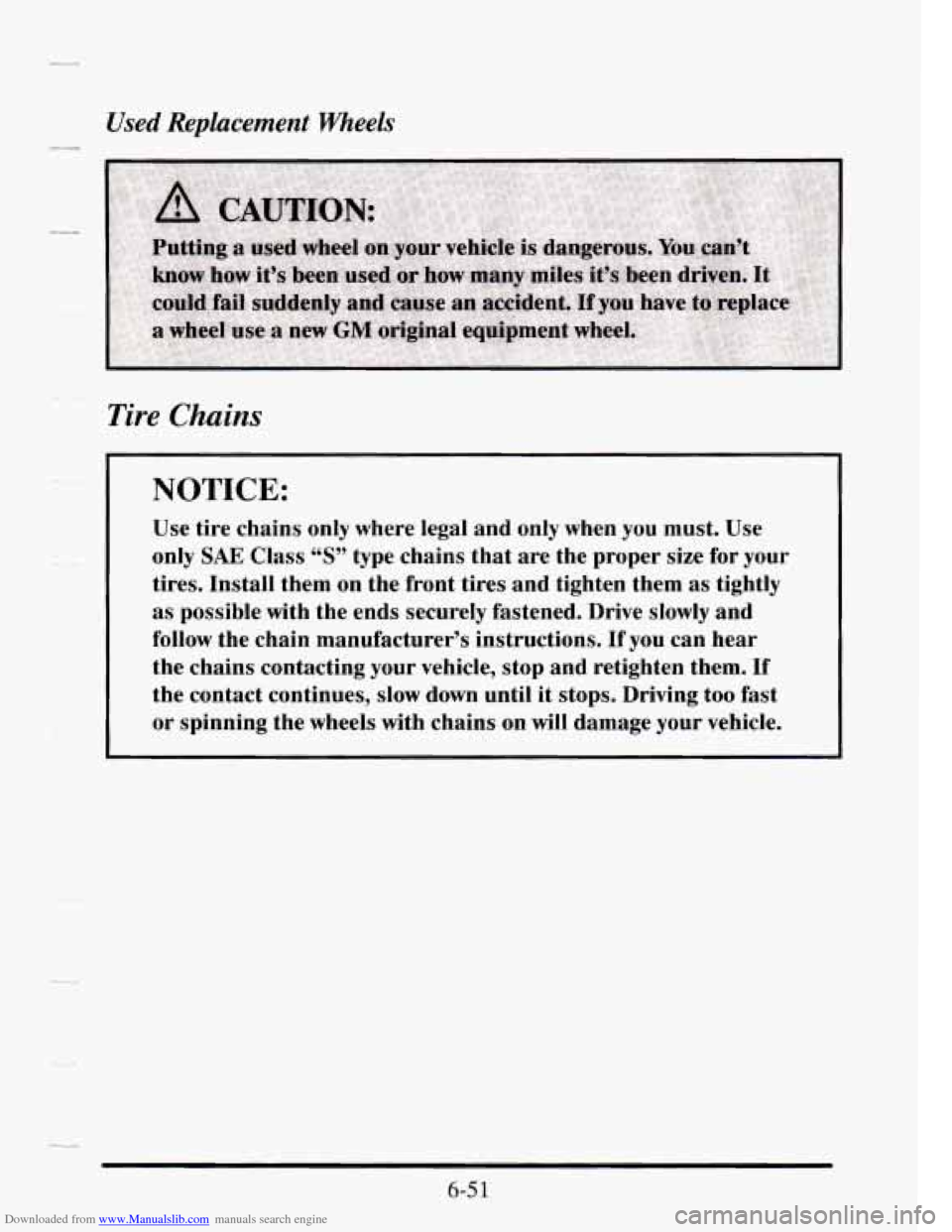tire type CADILLAC SEVILLE 1995 4.G Owners Manual
[x] Cancel search | Manufacturer: CADILLAC, Model Year: 1995, Model line: SEVILLE, Model: CADILLAC SEVILLE 1995 4.GPages: 410, PDF Size: 19.98 MB
Page 208 of 410

Downloaded from www.Manualslib.com manuals search engine LOSS OF CONTROL
Let’s review what driving experts say about what happens when the three
control systems (brakes, steering and acceleration) don’t have enough
friction where the tires meet the road to do what the driver has asked.
In any emergency, don’t give up. Keep trying to steer and constantly seek
an escape route or area of less danger.
Skidding
In a skid, a driver can lose control of the vehicle. Defensive drivers avoid
most skids by taking reasonable care suited to existing conditions, and by
not “overdriving” those conditions. But skids are always possible.
The three types
of skids correspond to your Cadillac’s three control
systems.
In the braking skid your wheels aren’t rolling. In the steering or
cornering skid, too much speed or steering in a curve causes tires to slip
and lose cornering force. And in the acceleration skid too much throttle
causes the driving wheels to spin.
A cornering skid is best handled by easing your foot off the accelerator
pedal.
Remember:
Any traction control system helps avoid only the acceleration
skid.
Page 249 of 410

Downloaded from www.Manualslib.com manuals search engine TOWING YOUR VEHICLE
Try to have a GM dealer or a professional towing service tow your
Cadillac. The usual towing equipment is:
A.
B.
C. Sling Type
Wheel Lift
Car Carrier
If your
adding
wheels, vehicle
has been changed or modified since it was factory-new by
aftermarket items like fog lamps, aero skirting or special tires and
these instructions and illustrations may not be correct.
Before you
do anything, turn on the hazard warning flashers.
When you call, tell the towing service:
0 That your vehicle cannot be towed from the front or rear with
sling-type equipment.
0 That your vehicle has front-wheel drive.
The make, model and year of your vehicle.
Whether you can still move the shift lever.
If there was an accident, what was damaged.
5-10
Page 316 of 410

Downloaded from www.Manualslib.com manuals search engine When to Check
- -c
- --
c-
Check your tires once a month or more.
Don’t forget your compact spare. It should be at
60 psi (420 kPa).
How to Check
Use a good quality pocket-type gage to check tire pressure. Simply looking
at the tires will not tell you the pressure, especially if you have radial
tires
-- which may look properly inflated even if they’re underinflated.
If your tires have valve caps, be sure to put them back on. They help
prevent leaks by keeping out dirt and moisture.
Tire Inspection and Rotation
Tires should be inspected every 6,000 to 8,000 miles (10 030 to 13 000 km)
for any signs
of unusual wear. If unusual wear is present, rotate your tires
as
soon as possible and check wheel alignment. Also check for damaged
tires or wheels. See “When it’s Time for New Tires” and “Wheel
Replacement’’ later in this section
for more information.
The purpose of regular rotation is to achieve more uniform wear for all tires
on the vehicle. The first rotation is the most important. See “Scheduled
Maintenance Services” in the Index for scheduled rotation intervals.
When rotating your
tires, always use the
correct rotation pattern
shown here.
Don’t include the compact spare tire in your tire rotation.
After the tires have been rotated, adjust the front and rear inflation
pressures as shown
on the Tire-Loading Information label. Make certain that
all wheel nuts are properly tightened. See “Wheel
Nut Torque” in the Index.
6-45
Page 318 of 410

Downloaded from www.Manualslib.com manuals search engine 0 The tire has a bump, bulge or split.
The tire has a puncture, cut, or other damage that can’t be repaired
well because
of the size or location of the damage.
Buying New Tires
To find out what kind and size of tires you need, look at the Tire-Loading
Information label.
The tires installed on your vehicle when it was new had a Tire
Performance Criteria Specification (TPC Spec) number on each tire’s
sidewall. When you get new tires, get ones with that same TPC Spec
number. That way, your vehicle
will continue to have tires that are
designed to give proper endurance, handling, speed rating, traction, ride
and other things during normal service on your vehicle. If your tires have
an all-season tread design, the TPC number
will be followed by an MS
(for mud and snow).
If
you ever replace your tires with those not having a TPC Spec number,
make sure they are the same size, load range, speed rating and
construction type (bias, bias-belted
or radial) as your original tires.
6-47
Page 320 of 410

Downloaded from www.Manualslib.com manuals search engine -c
4-
--
Warning: The temperature grade for this tire is established for a tire that
is properly inflated and not overloaded. Excessive speed, underinflation,
or excessive loading, either separately or
in combination, can cause heat
buildup and possible tire failure.
These grades are molded on the sidewalls of passenger car tires.
While the tires available as standard or optional equipment on General
Motors vehicles may vary with respect to these grades, all such tires meet
General Motors performance standards and have been approved for use
on General Motors vehicles. All passenger type
(P Metric) tires must
conform
to Federal safety requirements in addition to these grades.
Wheel Alignment and Tire Balance
The wheels on your vehicle were aligned and balanced carefully at the
factory to
give you the longest tire life and best overall performance.
In most cases, you
will not need to have your wheels aligned again.
However,
if you notice unusual tire wear or your vehicle pulling one way
or the other, the alignment may need to be reset. If you notice your
vehicle vibrating when driving on a smooth road, your wheels may need to
be rebalanced.
Wheel Replacement
Replace any wheel that is bent, cracked, or badly rusted or corroded. If
wheel nuts keep coming loose, the wheel, wheel bolts, and wheel nuts
should be replaced. If the wheel leaks air, replace
it (except some
aluminum wheels, which can sometimes be repaired). See your Cadillac
dealer
if any of these conditions exist.
Your dealer will know the kind of wheel you need.
Each new wheel should have the same load carrying capacity, diameter,
width, offset, and
be mounted the same way as the one it replaces.
- If you need to replace any of your wheels, wheel bolts, or wheel nuts,
replace them only with new GM original equipment parts. This way, you
will be sure to have the right wheel, wheel bolts, and wheel nuts for your
Cadillac model.
6-49
Page 322 of 410

Downloaded from www.Manualslib.com manuals search engine c -.-
--
--
--
Used Replacement Wheels
Tire Chains
NOTICE:
Use tire chains only where legal and only when you must. Use
only
SAE Class “S” type chains that are the proper size for your
tires. Install them on the front tires and tighten them
as tightly
as possible with the ends securely fastened. Drive slowly and
follow the chain manufacturer’s instructions.
If you can hear
the chains contacting your vehicle, stop and retighten them.
If
the contact continues, slow down until it stops. Driving too fast
or spinning the wheels with chains on will damage your vehicle.
6-5 1
Page 324 of 410

Downloaded from www.Manualslib.com manuals search engine c-
CLEANING THE INSIDE OF YOUR
CADILUC
Use a vacuum cleaner often to get rid of dust and loose dirt. Wipe vinyl or
leather with a clean, damp cloth.
Your Cadillac dealer has
two GM cleaners, a solvent-type spot lifter and a
foam-type powdered cleaner. They
will clean normal spots and stains very
well. Do not use them on vinyl or leather.
Here are some cleaning tips:
0 Always read the instructions on the cleaner label.
Clean up stains as soon as you can -- before they set.
Use a clean cloth or sponge, and change to a clean area often. A soft
0 Use solvent-type cleaners in a well-ventilated area only. If you use
brush
may be used
if stains are stubborn.
them, don’t saturate the stained area.
If a ring forms after spot cleaning, clean the entire area immediately or
it will set.
Using Foam-Type Cleaner on Fabric
Vacuum and brush the area to remove any loose dirt.
Always clean a whole trim panel or section. Mask surrounding trim
0 Mix Multi-Purpose Powdered Cleaner following the directions on the
along
stitch
or welt lines.
container label.
0 Use suds only and apply with a clean sponge.
0 Don’t saturate the material.
0 Don’t rub it roughly.
0 As soon as you’ve cleaned the section, use a sponge to remove the
suds.
Rinse the section with a clean, wet sponge.
Wipe off what’s left with a slightly damp paper towel or cloth.
Page 358 of 410

Downloaded from www.Manualslib.com manuals search engine i
r
r
t -
i
i
t
TOLL-FREE HOTLINE
1-800-882-1112
Roadside Service represents the spirit of luxury leadership at Cadillac
Motor Car Division. We hope the need never arises, but
if it does,
Roadside Service is there
for you!! Roadside Service covers. you on the
road, far from home, all day and night, weekends and holidays.
THERE
ARE NO MEMBERSHIP OR ENROLLMENT CHARGES. Any
Cadillac is eligible under this program.
ROADSIDE SERITCE AVNMILITY-
v
TYPE DAEY INCLUDING
OF ASSISTANCE
Phone Advisor
HOLIDAYS
24 Hours
Dealer Rchnician
8 a.m. - 12 midnight
. Towing
Battery Jump Start
Lockout Assistance Fuel Delivery
Tire Change 24 Hours
7 Cadillac Roadside Service is just one of your Cadillx 0wner.PrivilegesSm
that leads
to peace of mind.
F I
.- . ..